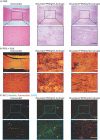A novel injectable fibromodulin-releasing granular hydrogel for tendon healing and functional recovery
- PMID: 36684085
- PMCID: PMC9842059
- DOI: 10.1002/btm2.10355
A novel injectable fibromodulin-releasing granular hydrogel for tendon healing and functional recovery
Abstract
A crucial component of the musculoskeletal system, the tendon is one of the most commonly injured tissues in the body. In severe cases, the ruptured tendon leads to permanent dysfunction. Although many efforts have been devoted to seeking a safe and efficient treatment for enhancing tendon healing, currently existing treatments have not yet achieved a major clinical improvement. Here, an injectable granular hyaluronic acid (gHA)-hydrogel is engineered to deliver fibromodulin (FMOD)-a bioactive extracellular matrix (ECM) that enhances tenocyte mobility and optimizes the surrounding ECM assembly for tendon healing. The FMOD-releasing granular HA (FMOD/gHA)-hydrogel exhibits unique characteristics that are desired for both patients and health providers, such as permitting a microinvasive application and displaying a burst-to-sustained two-phase release of FMOD, which leads to a prompt FMOD delivery followed by a constant dose-maintaining period. Importantly, the generated FMOD-releasing granular HA hydrogel significantly augmented tendon-healing in a fully-ruptured rat's Achilles tendon model histologically, mechanically, and functionally. Particularly, the breaking strength of the wounded tendon and the gait performance of treated rats returns to the same normal level as the healthy controls. In summary, a novel effective FMOD/gHA-hydrogel is developed in response to the urgent demand for promoting tendon healing.
Keywords: fibromodulin; functional reconstruction; granular hydrogel; hydrogel microparticles; tendon wound healing.
© 2022 The Authors. Bioengineering & Translational Medicine published by Wiley Periodicals LLC on behalf of American Institute of Chemical Engineers.
Conflict of interest statement
Drs. Kang Ting, Chia Soo, and Zhong Zheng are the inventors on FMOD‐related patents assigned to UCLA. Drs. Kang Ting, Chia Soo, and Zhong Zheng are also founders and officers of Scarless Laboratories, Inc., which sublicenses FMOD‐related patents from the UC Regents, who also hold equity in the company.
Figures







Similar articles
-
Prescription of Controlled Substances: Benefits and Risks.2025 Jul 6. In: StatPearls [Internet]. Treasure Island (FL): StatPearls Publishing; 2025 Jan–. 2025 Jul 6. In: StatPearls [Internet]. Treasure Island (FL): StatPearls Publishing; 2025 Jan–. PMID: 30726003 Free Books & Documents.
-
The Black Book of Psychotropic Dosing and Monitoring.Psychopharmacol Bull. 2024 Jul 8;54(3):8-59. Psychopharmacol Bull. 2024. PMID: 38993656 Free PMC article. Review.
-
Programmed drug delivering Janus hydrogel adapted to the spatio-temporal therapeutic window for Achilles tendon repair.Acta Biomater. 2025 Jul 1;201:139-155. doi: 10.1016/j.actbio.2025.05.052. Epub 2025 May 22. Acta Biomater. 2025. PMID: 40412506
-
Short-Term Memory Impairment.2024 Jun 8. In: StatPearls [Internet]. Treasure Island (FL): StatPearls Publishing; 2025 Jan–. 2024 Jun 8. In: StatPearls [Internet]. Treasure Island (FL): StatPearls Publishing; 2025 Jan–. PMID: 31424720 Free Books & Documents.
-
The Promising Hydrogel Candidates for Preclinically Treating Diabetic Foot Ulcer: A Systematic Review and Meta-Analysis.Adv Wound Care (New Rochelle). 2023 Jan;12(1):28-37. doi: 10.1089/wound.2021.0162. Epub 2022 Apr 11. Adv Wound Care (New Rochelle). 2023. PMID: 35229628
Cited by
-
Characterization of a decellularized pericardium extracellular matrix hydrogel for regenerative medicine: insights on animal-to-animal variability.Front Bioeng Biotechnol. 2024 Aug 14;12:1452965. doi: 10.3389/fbioe.2024.1452965. eCollection 2024. Front Bioeng Biotechnol. 2024. PMID: 39205858 Free PMC article.
-
Small leucine rich proteoglycans: Biology, function and their therapeutic potential in the ocular surface.Ocul Surf. 2023 Jul;29:521-536. doi: 10.1016/j.jtos.2023.06.013. Epub 2023 Jun 22. Ocul Surf. 2023. PMID: 37355022 Free PMC article. Review.
-
The role of fibromodulin in myocardial fibrosis in a diabetic cardiomyopathy rat model.FEBS Open Bio. 2025 Mar;15(3):436-446. doi: 10.1002/2211-5463.13935. Epub 2024 Nov 26. FEBS Open Bio. 2025. PMID: 39592912 Free PMC article.
-
Identification of age-related genes in rotator cuff tendon.Bone Joint Res. 2024 Sep 10;13(9):474-484. doi: 10.1302/2046-3758.139.BJR-2023-0398.R1. Bone Joint Res. 2024. PMID: 39253760 Free PMC article.
-
Understanding Tendon Fibroblast Biology and Heterogeneity.Biomedicines. 2024 Apr 12;12(4):859. doi: 10.3390/biomedicines12040859. Biomedicines. 2024. PMID: 38672213 Free PMC article. Review.
References
-
- Voleti PB, Buckley MR, Soslowsky LJ. Tendon healing: repair and regeneration. Annu Rev Biomed Eng. 2012;14:47‐71. - PubMed
Grants and funding
LinkOut - more resources
Full Text Sources

